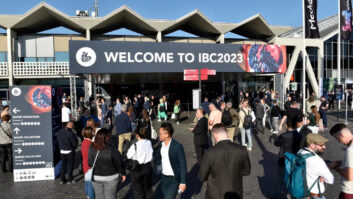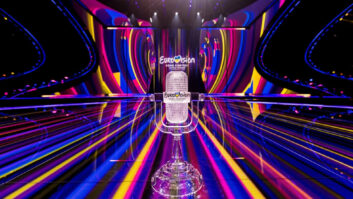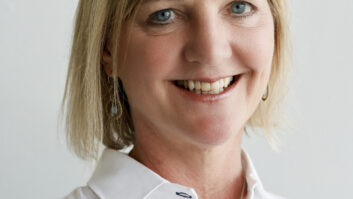
Lighting
Dedo Weigert Film – Dedolight Ledzilla upgrade
The small, flexible on-camera light can now do a lot more. Users can take its barn door off and turn it into a tube light (useful for car interiors) or add a Chinese lantern or a soft box (with standard or tungsten conversion cloth), and it has a slot for fitting any of the tiny gels you get from a swatch of filters. “Now you have all the filter colours you want, in your pocket,” said Dedo Weigert (pictured).
www.dedoweigertfilm.de
F&V/Dedo Weigert Film – Z.96/TechPro Fillini Click
This on-camera light has been jointly developed by a Chinese manufacturer and the Dedolight maker, each adding practical innovations, such as the ability to click up to four lights together to make a big LED panel. The lights can be powered by five AA batteries or one Sony L-series battery (which can then be used to power up to four clicked together). The diffuser and tungsten filters are magnetic, making it easy to double up, and the lamps offer bright output and a wide-angle beam.
www.dedoweigertfilm.de
www.fvlight.com
Gekko – kezia
The hard-source lights are based on Gekko’s kleer colour tunable LED light engine. They provide a high volume of even light, the colour temperature of which can be accurately set at points between 2900 and 6500K. Colour temperature stability is maintained via a feedback loop, automatically adjusting to cope with rising ambient temperature, for example. Each lamp is calibrated to ensure consistency and can dim with no change in colour. There are kezia 800, 200 and 50W fixtures (offering light outputs equivalent to traditional lights using four or five times the power), controllable via DMX.
www.gekkotechnology.com
Litepanels – Sola
These LED Fresnel lights use about a tenth of the power of traditional fixtures. The daylight-balanced models, for on-camera and off-camera use, provide beam control of 70° to 10°. The 75W Sola6 (equivalent to a 650W tungsten) provides on-fixture motorized control of focus and local dimming via a convenient touch screen, and are also remote-controllable via their integrated DMX interface. The 30W SolaENG on-board light (250W tungsten equivalent) has manual focus and dimming control via camera lens style controls. There will also be a 250W Sola12.
www.litepanels.com
Photon Beard – Wi-Light
Low-cost wireless control for studio lighting, using WiFi. “The need to run a DMX cabled network can be time consuming and messy. Wi-Light does away with the need for in/out DMX leads making installation very quick and easy – simply hang the light and apply power, link it to the wireless network and it is ready to use,” explained MD Peter Daffarn (pictured). Transmitter range is up to 100m, extendable using repeaters. DMX512 sends data continuously even when nothing changes, which is wasteful for wireless, so Wi-Light transmits only the changes, and includes error checking, unlike the DMX512 standard.
www.photonbeard.com
Videssence – ExceLED
These LED key lights include 25W, 50W and 100W fixtures, designed for broadcast or studio general accenting, key lighting or back lighting. The concentrated beam of the 25 ‘can compete with many 500 or 650W Fresnel fixtures in spot beam focus’, while the 50 comes close to many 1kW Fresnel fixtures in spot beam focus. The ExceLED 100 is claimed to be the most powerful 100W light beam available in LED, and can provide an adjustable beam-spread without lenses, using only one set of LEDs.
www.videssence.tv
Support
Bradley Engineering – Skytrac HD
This cablecam was built for Stuart Bush, owner of Remote Solutions (pictured left) by David Bradley (right), and made its debut covering the Ryder Cup Golf for Sky Sports. It is designed to look good in shot, be weather proof and very safe for use above crowds, and is fitted with Bradley’s new Gyro 350 five-axis stabilised gimbal.
www.bradeng.com
Element Technica – Neutron and Pulsar
These compact and mid-size 3D rigs join ET’s existing Quasar (which was widely used for the World Cup). The Neutron is designed for small HD cameras, such as the SI-2K or Iconix carrying C-mount lenses, and is suitable for Steadicam use. The Pulsar can cope with larger cameras, such as the Sony EX3 or P1, with ENG-style lenses. The motion module on the Pulsar is about 2.5cm wider than on the Neutron to allow for greater interocular distances with larger cameras
www.elementtechnica.com
Vinten – Vector 430
This fluid head has a very wide payload capacity (10kg to 43kg), giving users a single choice when two heads may have previously been required, making it particularly useful for production companies working with multiple camera set-ups, or for rental companies. It is also available with a high-quality, highly accurate encoder (as the Vector 430i) for virtual reality applications.
www.vinten.com
Vinten – Vector 750i
This is Vinten’s first encoded pantographic head, designed for virtual and augmented reality applications for outside broadcast or studio use. It has a new Intelligence Module allowing semi automatic set-up, slide plate tracking and kinematic compensation, to ensure stable and precise placement of virtual graphics into a live environment. There is also an optional inclinometer that compensates for any camera movement caused by, for example, another person stepping onto an unstable camera position.
www.vinten.com







